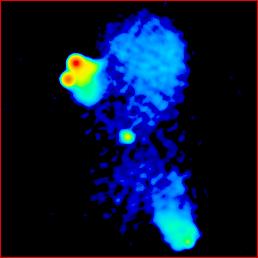 Image:
Image:3C 351 | B1704+608 |
| S178 | Alpha | FR | Class | ID | Spectrum | Best z | mag. | LAS | lg P178 | D |
|---|---|---|---|---|---|---|---|---|---|---|
| 14.9 | 0.73 | II | CD | QSO | 0.371 | V = 15.28 | 75.00 | 26.52 | 309.5 |

| Size: | 76.8 × 76.8 arcsec² |
|---|---|
| LUT: | Logarithmic |
| Beam: | 1.85 arcsec |
| Frequency: | 1417 MHz |
| Method: | CLEAN Õ˜ÿ>1.85
|
| Telescope: | VLA A+B |
| Credits: | Leahy & Perley (1991), R. A. Laing (priv comm) |
The large displaced NW lobe can be compared to the misaligned lobes in 3C 215 and 3C 249.1. These displaced lobes seem to be relatively common in 3C quasars and very rare in radio galaxies, although 3C 295 is an example in the latter case. According to unified schemes, quasars are seen at smaller angles to the line of sight than radio galaxies, and so should be more distorted by projection effects. It is not clear whether this is enough to cause the very large lobe displacements in these quasars; on the other hand the effect could just be a statistical fluke as there are not many 3C quasars altogether.
An alternative possibility for 3C 351 is that it shows a rather asymmetric pair of wings, as there are signs of a matching (but much fainter) displaced lobe to the south of the core.
An HST image (Boyce et al. 1998) reveals an elliptical galaxy surrounding the quasar, which like most quasars is a moderately bright X-ray source.
The mottling in the fainter regions of our image
is an artifact of the imaging process, caused by
the very bright northern hotspots.
| Prev. | Data Page | Other images | Next | Search | Alphanumeric List | Icon List | Atlas Index |
|---|